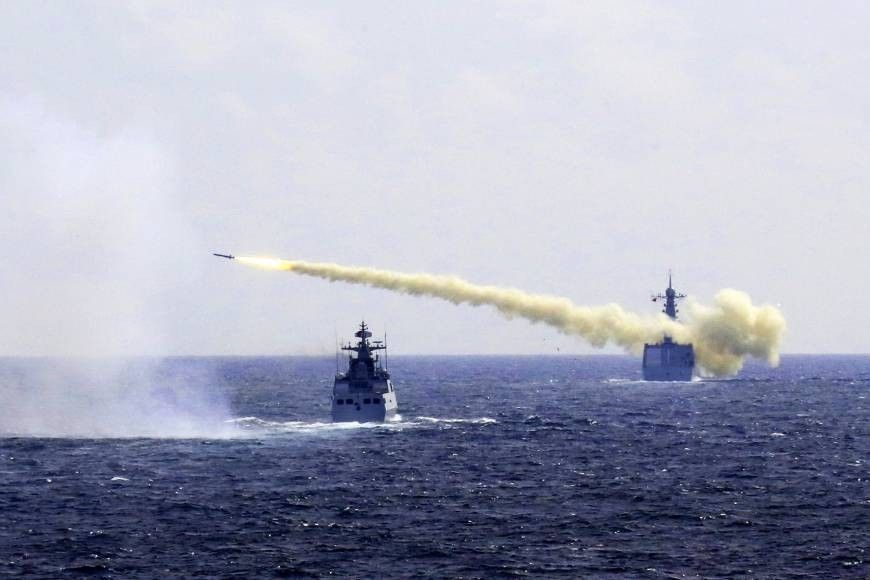Conditions in the SCS over the last 2 years

MANILA, Philippines — On July 12, 2016, the Permanent Court of Arbitration (PCA) released its ruling on a claim brought by the Philippines against China on the South China Sea disputes between those two countries. The court rejected China’s claims on all thirteen issues taken up by the Philippines. But China refused to recognize the ruling and maintains its position today.
Over the last two years, the disputes between the international community and China have remained largely unchanged, on the sidelines of the North Korea issue. In the same time frame, however, China’s militarization of the artificial islands has seen tensions quietly rise.
3 fundamental features of the sea disputes
China has maritime issues with numerous countries in the South and East China Seas, but the essence of these issues can be roughly classified into the following three points:
1. Dominion over maritime features
China has come in conflict with many coastal countries with regard to dominion over maritime features in the South China Sea. China has claimed the areas surrounded by the “nine-dash line” as historic rights and indisputable sovereignty since before the Common Era. The South China Sea Code of Conduct (COC) framework agreement of August 2017 seems unlikely to resolve the dominion disputes soon.
2. Construction of artificial islands and their militarization
Many maritime features in the South China Sea are expansions or reinforcements of existing large maritime features. China has also constructed artificial islands in several locations, including three large atolls on which it is possible to construct airports. China proceeded with its construction projects despite the terms of the aforementioned PCA ruling. The conflict between the international community and China is intensifying.
Chinese President Xi Jinping and US president Barack Obama reached an agreement on the non-militarization of the South China Sea in September 2015. The agreement was interpreted as meaning “China, which is forging ahead with the construction of artificial islands, will not militarize artificial islands.” China however has claimed, “The construction of any military installations and the deployment of military troops in our historic rights and indisputable sovereignty are a matter of state sovereignty and also just measures for defending ourselves as an independent state.”
China argues that US military activities, including Freedom of Navigation Operations (FONOPS), amount to the militarization of the South China Sea and justified its construction of military installations on these grounds.
In May this year, it was reported that the Chinese military’s large bomber H-6 had landed on the island for the first time.
In addition, it has been confirmed that China constantly flies military transport planes over artificial islands and sends naval vessels to the islands. In addition to constructing radar facilities for early warning and surveillance as well as air control, and setting numerous information-collecting devices in place, China deploys anti-air and anti-ship missiles and electronic jamming devices.
In this way, China is steadily militarizing the South China Sea, completely ignoring the agreement between the leaders of the United States and China.
3. The open sea and internal waters
Japan and the United States regard territorial waters as the open sea, where everyone is guaranteed free navigation, but China has a unique interpretation of the international standards.
China’s claim is an attempt to bring the open seas of the South China Sea under the UNCLOS definition “internal waters,” giving it almost the same authority as territorial waters.
However, the open sea is waters to which UNCLOS and customary international law are applied. According to these two internationally recognized rules, even sailors in distant countries can navigate freely and safely in waters with which they are unfamiliar, regardless of their geographical positions.
If China’s claims were accepted, much of the South China Sea would become waters to which many Chinese domestic laws that sailors all over the world hardly know or do not need to know were applied. This would mean the destruction of the age-old international maritime order.
Freedom of Navigation Operations
The US military FONOPS is the diplomatic action of operating naval vessels as a means of demonstrating US interpretation to a particular country when the United States and said country interpret the UNCLOS stipulations differently. FONOPS is not aimed solely at China.
US military FONOPS in the South China Sea can be divided into the following two cases: harmless navigation of military vessels according to the stipulations of UNCLOS in territorial waters whose sovereign state is undetermined with maritime features whose sovereign state has yet to be determined being the reference point; and free navigation according to China’s interpretation of UNCLOS, especially in the waters where China claims surrounding maritime features that cannot be the reference point of territorial waters; that is, the waters (the open sea) where there are no territorial waters stipulated by UNCLOS according to the US interpretation.
The harmless navigation of territorial waters defined by UNCLOS demonstrate warships’ rights. FONOPS are not designed to prevent a particular country from claiming a territorial issue or to call for the cessation of the construction of artificial islands. Given the large gaps between the United States and China in their interpretations of UNCLOS, US FONOPS will continue to be conducted several times a year.
China is contained by chains of islands
China, which is surrounded on its southern and eastern sides by the South and East China Seas, has the critical disadvantage of being contained geographically by neighboring countries. Chinese maritime and air forces must go through several choke points1 in order to advance into open-sea operational waters and air spaces. In particular, there are just four channels that are more than 100 meters deep where submarines can navigate from the South China Sea to the open sea, submerged, where they could pose a serious threat to US forces. If these channels were blocked, it would be a critical blow to the Chinese maritime and air forces.
Japan and the United States can contain the advance of Chinese maritime and air forces into the open sea and block the maritime traffic that is so essential for China’s survival by drawing up a strategy of controlling the aforementioned choke points and building up defensive capabilities. This would work as an effective deterrent to today’s China and back up diplomatic activities. Both Japan and the United States are expected to adjust their strategies from this perspective. For Japan, building up its defense capability with this strategy in mind is essential. — Yoji Koda Former commander of the Japan Maritime Self-Defense Force Fleet
- Latest
- Trending




























